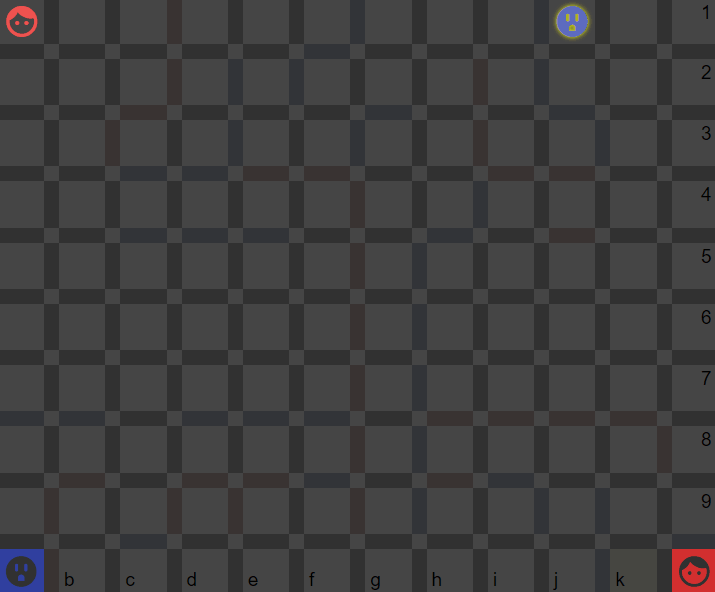Projects
Click on a project name for a brief explanation.
-
Wallwars is an online 2-player strategy board game. The player who gets to their goal before first wins. You can place walls to reshape the terrain to your advantage. WallWars is inspired by board games like Blockade and Quoridor. I built it to learn the MERN stack.

-
Network alignment is the algorithmic problem of how to map biological networks to discover their similarities. It can be seen as the analogous of sequence alignment, but for graphs instead of strings. This makes the problem NP-hard. For my undergrad thesis, I developed an algorithm based on the simulated annealing metaheuristic which substantially outperformed other existing methods. The project spawned a series of papers, of which I am a coauthor on two of them (papers [C1,C2]).
-
The RACSO online Judge is a teaching tool for the subject of «Theory of Computation». It contains a collection of automatically-evaluated exercises asking to define recognizers/generators of formal languages (regular or context-free), as well as exercises asking for reductions between problems (undecidable or NP-complete). The judge also contains exercises for a compilers course.
RACSO was developed at Polytechnic University of Catalonia, where it is used for homework and even for exams. After using it myself as a student, I started a working on expanding it. I contributed most of the exercises in the lists for reductions to SAT and syntax parsers, and some exercises in other lists. I also helped code the interpreter for the language in which the SAT reductions are given.
The interesting aspect of these judges is that the evaluation is not simply based on test cases. Here is a technical report about the inner workings of the judge for evaluating syntax parsers.
-
BwE: Flexible, Hierarchical Bandwidth Allocation for WAN Distributed Computing
is a public research paper from Google which introduces the Bandwidth Enforcer (BwE) network allocation algorithm used in Google's internal WAN. Among other things, it introduces the notion of bandwidth functions and how to aggregate them in a fair way. I made an interactive app to recreate the examples from the paper and be able to explore how they would change with different parameters.
For more context on the problem of fair network allocation, check out the BwE paper.
-
The
two-list stable matching problem
is an open problem in the field of market design. I made an interactive visual exploration tool to assist in solving it. See the github page for a description of the problem and the tool.The demo requires a mouse, so it is not friendly to mobile browsers.
-
My research often has geometric aspects, and geometric concepts are not easy to convey in text form. To aid in this, I made the Simplified SVG library which accepts geometric primitives, specified in JSON, and shows the result on the resulting drawing in the browser using SVG. This is useful to visualize computationally-generated geometric data and avoid having to draw it out by hand.
While drawing software with support for
scripting
already exists, I kept the syntax minmalistic so that it is easy to generate the drawing instructions from any language/environment, and instead of running a drawing software/library, one can just copy-paste them on the sandbox.Note: the sandbox is not intended for mobile browsers.
-
Sanim is both a markup language for preparing presentations, and a parser for this language that produces the presentations. The transition between slides is animated using Manim.
Manim (Math ANIMation) is an animation engine for explanatory math videos made for the youtube channel 3Blue1Brown.
Sanim encapsulates Manim so that the user can prepare slides with a style similar to Manim but without needing to write code. In addition, the slides are displayed in a browser, and the user can trigger the forward and backward animations using arrow keys.
For the demo, use the right arrow key to show the slides (not possible on mobile browsers). See more on the github repo.
-
An in-memory hash table that acts as a Cache for a Key-Value storage. It is inspired by Redis and Memcached. It has an LRU (least recently used) eviction mechanism, and it also supports timeouts: entries expire after a certain TTL (
time-to-live
). The project focuses on how to handle expired entries. They can be handled in two ways: 1) passively, when they arediscovered
through read/write operations. 2) actively, by searching for them.Using only passive removal may result in the LRU mechanism evicting entries that are still
alive
while the cache is poluted by expired entries. Memcached uses a segmented LRU mechanism which takes TTL's into account. It can be considered as a type of passive removal. In contrast, Redis implements an active probabilistic algorithm to keep the fraction of expired entries low, which I implemented in this project. In the future, this project may serve as a testbed for comparing different algorithms for handling expired entries.
More projects on my Github page.